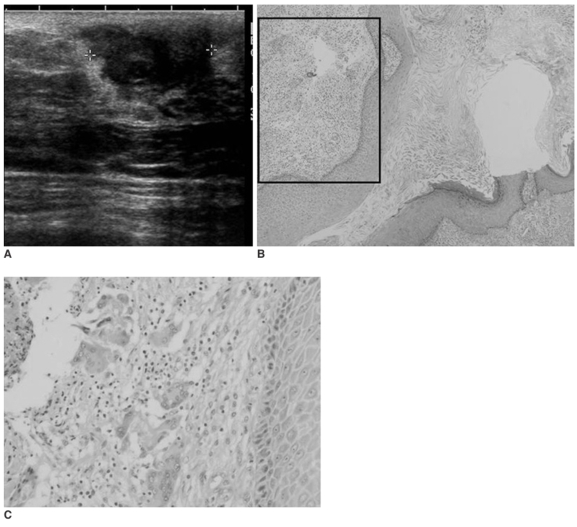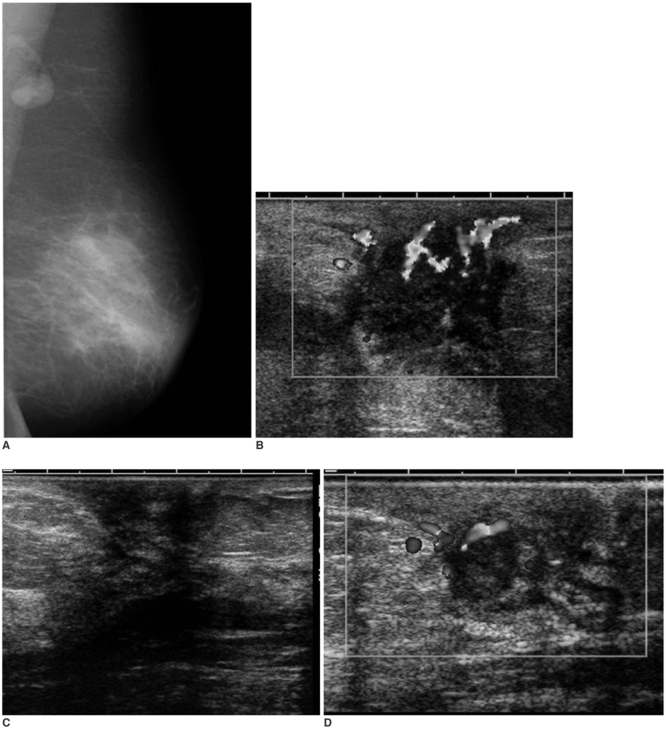Abstract
Epidermal inclusion cyst of the breast is an uncommon benign lesion and it is usually located in the skin layer. We report here on two cases of ruptured epidermal inclusion cysts in the subareolar area, which is a very unusual location for these cysts and these lesions can be mistaken for breast malignancies.
Keywords: Epidermal inclusion cyst; Breast, US; Breast neoplasm
Although the epidermal inclusion cyst is an uncommon finding in the breast, we can easily diagnosis this as a cyst. But when it is presented in an unusual subareolar location and with a ruptured state, it can be mistaken for breast malignancy. We present here two surgically confirmed cases of ruptured epidermal inclusion cyst in a subareolar location, and this has not been previously described in the English medical literature.
CASE REPORTS
Case 1
A 50-year-old woman presented with left subareolar pain and a bean-sized palpable mass for one week. Sonography reveals an ill defined heterogeneous, hypoechoic, irregular shaped 1.8×1.1-cm mass in the left subareolar region (Fig. 1A). Fine needle aspiration biopsy (FNAB) showed copious eosinophils, small amounts of ductal epithelium and no malignant cells. According to the patient request, excision was performed and the mass was pathologically confirmed as a ruptured epidermal inclusion cyst (Figs. 1B, C).
Fig. 1.
A 50-year-old woman with a palpable left subareolar mass.
A. Sonography shows a heterogeneoulsy hypoechoic mass with an indistinct margin.
B. Photomicrograph shows that the lesion is lined by epidermal-type epithelium and it is filled with keratinous material, which is pathognomonic for an epidermal inclusion cyst. (Hematoxylin & Eosin staining × 40)
C. Photomicrograph of adjacent tissue (box in B) reveals inflammatory infiltrate cells or a foreign body reaction. (Hematoxylin & Eosin staining × 100)
Case 2
A 44-year-old woman presented with left periareolar pain for several months. Mammography revealed left subareolar asymmetry, periareolar skin thickening and axillary lymph node hypertrophy (Fig. 2A). Sonography shows a 2.2×1.7-cm ill defined mass with an irregular shape, heterogeneous echogenicity and posterior enhancement (Fig. 2B). FNAB was performed to differentiate this from inflammatory breast cancer, but malignant cells were not found. The symptoms were improved after administering antibiotics, and we formed a clinical impression of breast abscess. One year later, the patient presented again with yellowish discharge of the left nipple. On the follow up mammogram, the density of the left subareolar asymmetry and skin thickening was decreased, but it was still observed, and no significant change was observed in the left axillary lymph nodes. On sonography, the previously observed mass showed decreased size (1.5×1.5-cm) and echogenicity. One month after antibiotic administration, the mass disappeared and an irregularly shaped hypoechogenicity was seen on the follow-up sonogram (Fig. 2C). About seven months later, the patient presented with a heat sensation and pain on the same area. The previous hypoechogenicity area changed to a 1.1×0.8-cm mass on sonography and a recurrent abscess was suspected (Fig. 2D). The mass was excised and pathologically confirmed as a ruptured epidermal inclusion cyst.
Fig. 2.
A 44-year-old woman with periareolar pain of the left breast.
A-D. The initial mediolateral oblique mammogram shows asymmetry of the left subareolar area, periareolar skin thickening and axillary lymphadenopathy (A), and the initial sonography shows a heterogeneous mass with peripherally increased vascular flow (B). About one year after medical treatment, the mass disappeared on sonography with a remaining Ill defined low echoic subareolar portion (C). The discrete subareolar mass was again noted seven months later on sonography when she revisited the hospital with a heat sensation and tenderness (D).
DISCUSSION
Less than 10% of epidermal inclusion cysts occur in the extremity and an even lower number occur in the palms, sole, and breast. Most breast epidermal inclusion cysts occur in the skin layer, but there is a report of occurrence in the breast parenchyma (1).
Epidermal inclusion cysts can be congenital, or they can occur after trauma, reduction mammoplasty (2) and breast augmentation (3). There is also a possibility of metaplastic lesions from columnar cells that have transformed into squamous cells, and there has been one reported case where the hair follicles or pores are obstructed and inflammatory downward growth of the epidermis made an inclusion cyst like the ones formed from sebaceous glands. Gerlock reported two cases of breast epidermal inclusion cysts associated with FNAB (4). Diverse complications can occur with epidermal inclusion cysts, like spontaneous rupture and the development of squamous cell cancer (5). In spontaneous rupture, these cysts release nonabsorbable keratin that acts as an irritant leading to secondary foreign body-type reactions, granulomatous reactions or abscess formation. Some authors have reported Paget's disease arising from not only the nipple epidermis, but also from perinipple epidermal inclusion cysts (6). Asymptomatic lesions do not require treatment, and biopsy is unnecessary if typical sonographic and physical examination findings are found. However, in cases presenting with palpable breast lesions, the patients are often concern about lumps and may request excision. Although a palpable breast mass shows benign findings on mammography, if the sonographic findings need to be differentiated from a well defined breast malignancy, then biopsy is necessary. To prevent inflammatory and malignant change, surgical intervention may be appropriate if circumstances require it. Several different entity diseases or periductal mastitis, abscess, retroareolar malignancies, intraductal papillary lesion and rarely Paget's disease could have caused the symptoms of our cases on initial presentation. But after sonography, the differential diagnosis of abscess and malignancy were taken into accounts (7, 8).
In our cases, we first considered the possibility of breast malignancy because the masses presented as an irregular mass on the initial sonography, and the patients were over the age 40 and we didn't take the possibility of abscess from ruptured epidermal inclusion cyst into consideration due to its rare occurrence and the unusual lesion location. FNAB and follow up imaging study after medical treatment, or the recurrent feature were the ways to later narrow the differential diagnosis. In conclusion, when a subareolar lesion has findings on sonography that are suspicious of malignancy, the differential diagnosis should include a ruptured epidermal inclusion cyst, with or without evidence of inflammation.
References
- 1.Kwak JY, Park HL, Kim JY, Kim EK, Chung SY, Kwon TH, et al. Imaging findings in a case of epidermal inclusion cyst arising within the breast parenchyma. J Clin Ultrasound. 2004;32:141–143. doi: 10.1002/jcu.20005. [DOI] [PubMed] [Google Scholar]
- 2.Fajardo LL, Bessen SC. Epidermal inclusion cyst after reduction mammoplasty. Radiology. 1993;186:103–106. doi: 10.1148/radiology.186.1.8416547. [DOI] [PubMed] [Google Scholar]
- 3.Denison CM, Ward VL, Lester SC, DiPiro PJ, Smith DN, Meyer JE, et al. Epidermal inclusion cysts of the breast: three lesions with calcifications. Radiology. 1997;204:493–496. doi: 10.1148/radiology.204.2.9240542. [DOI] [PubMed] [Google Scholar]
- 4.Gerlock AJ. Epidermal inclusion cyst of the breast associated with needle biopsy. Radiology. 1974;112:69–70. doi: 10.1148/112.1.69. [DOI] [PubMed] [Google Scholar]
- 5.Hasleton PS, Misch KA, Vasudev KS, George D. Squamous carcinoma of the breast. J Clin Pathol. 1978;31:116–124. doi: 10.1136/jcp.31.2.116. [DOI] [PMC free article] [PubMed] [Google Scholar]
- 6.Stephenson TJ, Cotton DWK. Paget's disease in an epidermal cyst. Dermatologica. 1987;174:186–190. doi: 10.1159/000249171. [DOI] [PubMed] [Google Scholar]
- 7.Crowe DJ, Helvie MA, Wilson TE. Breast infection Mammographic and sonographic findings with clinical correlation. Invest Radiol. 1995;30:582–587. [PubMed] [Google Scholar]
- 8.Giess CS, Keating DM, Osborne MP, Ng YY, Rosenblatt R. Retroareolar breast carcinoma: clinical, imaging, and histopathologic features. Radiology. 1998;207:669–673. doi: 10.1148/radiology.207.3.9609889. [DOI] [PubMed] [Google Scholar]




